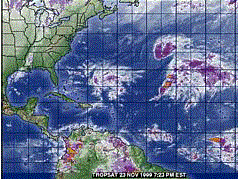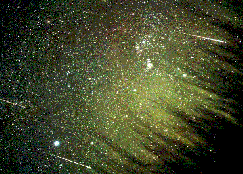

Mission Status Report #25 Star Date: November 23, 1999 NOTE: Mission Status Reports on the web page will continue roughly once a week. 

Remnants of hurricane Lenny (left) and Leonid meteors near Orion (right).
FUSE Survives Two Storms!FUSE (both the satellite and the project!) had to ride out TWO storms of very different kinds during the last week. Hurricane Lenny skirted Puerto Rico, threatening a direct hit on the western coast (close to Mayaguez, where our primary ground station resides) before swinging just to the south and east of the island. We were relieved not only for the antenna, but for our support personnel and friends at UPRM. The ground station and associated hardware were powered down prior to the storm as a precaution. When power was restored, we unfortunately found that we had the problem that has occurred twice before whereby we couldn't command the satellite through the UPRM station. We used NASA Wallops and Universal Spacenet (Hawaii) as backups while the problem was debugged. After several days of intense effort, the station is back up now and working properly again. The other "storm" was the much-heralded Leonids meteor storm that occurred early last Thursday morning, just about the time Lenny was making it's pass by Puerto Rico. We successfully oriented FUSE to point in the direction away from any ongoing meteors during the critical time period and turned off the high voltage to FUSE's light detectors. After riding out the storm (with no noticable effects!), we performed several days of tests that needed to be done while the high voltage was down (on in the process of being turned on again). This was more efficient in the long run so we won't have to ramp the detector voltage down again for these tests in the future. Just prior to the Leonids down time, and now again this week, we are running primarily concentrated checkout programs to put the satellite in a configuration to allow the real "science mission" to begin in earnest. Over the next few weeks, we expect science observations to start rolling in on a more regular basis for both the FUSE Science Team and our Guest Investigators.
On a related note, please allow me to explain briefly some apparent misconceptions. A couple of recent newspaper reports have left the wrong impression with many people, that FUSE either "isn't working" or "can't be focused", etc. This is simply not true! The problems we have had are more in the category of "start-up problems" and "growing pains", not mission threatening. The checkout period has been longer than we would like, and we have already overcome many challenges. I have tried to be very forthright in outlining these problems for you in these reports. The apparent slow pace of checkout can be attributed largely to our limited (and sometimes problematic) contact with the satellite. While we would love to have more contacts and a faster checkout, you must realize that this was the way the mission was designed! Right or wrong, when FUSE was de-scoped in 1994 to fit into NASA's new "faster, cheaper, better" mode of operation, a single ground station was the baseline (you have to get "cheaper" somehow!), and a single ground station WILL BE SUFFICIENT when we are in normal operations. But this situation simply has not been sufficient to complete the checkout period in a timely way. And so we do what we can. We have made extremely good progress over the last month in characterizing the mirror motions I have described in previous reports. We are now testing operational aspects of managing this situation now, and will work these into the system over the next few weeks. Let me also reiterate that we are taking significant science data even as we continue work to optimize the system. We have currently observed about 40 objects with FUSE, some for only a few thousand seconds and some for as much as 50 thousand seconds. Many of these spectra far surpass any existing FUV spectral data on these targets even though we have not optimized the telescope yet! Over two dozen results will be presented at the American Astronomical Society meeting in January (in Atlanta) on some of these data. These results are "embargoed" by NASA until that time (which means we are not supposed to show them to you!). And that is the only reason you have not seen FUSE spectra displayed yet on the FUSE Web site! We are working with the project to prepare a few example data sets that we can release for use on the Web site. We hope to be able to show some data in the near future. Reported by: Bill Blair, Chief of Mission Planning
|